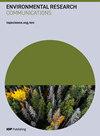An extensive qualitative and quantitative multi criteria analysis for a hybrid renewable energy system applied to tribal zone - based primary health centres, and maximizing the societal parameters
IF 2.5
4区 环境科学与生态学
Q3 ENVIRONMENTAL SCIENCES
引用次数: 0
Abstract
Remote electrification enhances the quality of life quality of people in remote areas, with no access to electricity through distributed coverage of electricity. Due to the irregular and unbalanced fuel cost and impracticable expansion of the grid, hybrid integrated renewable energy sources become dependable substitute for remote electrification. The necessity of uninterrupted power dispatch is a prime factor for primary health centres, located in tribal and remote areas. This article proposes an integrated primary analysis like financial, production, quantity and environmental, applied to an optimum sizing of a hybrid standalone renewable energy source, which might be carried out in eight primary health centres, situated in the Gudalur Zone in Nilgiris District, Tamil Nadu, India. Four different criteria were inspected in this study, as standard loading, boost up loading, step down loading and complete renewable loading. In addition, every criterion was assessed with four kinds of PV tracking arrangements. HOMER Pro Micro-grid Analysis Tool was used, to analyze the different primary parameters of this study. The foremost financial parameters like COE (Cost of Energy) and NPC (Net Present Cost), could range from 0.102 to 0.118 $ per kWh and from 0.4047 to 0.5708 Million $ respectively.对应用于部落地区初级保健中心的混合可再生能源系统进行广泛的定性和定量多标准分析,并最大限度地提高社会参数
偏远地区电气化通过分布式供电提高了偏远地区无电人口的生活质量。由于燃料成本不规则、不平衡,以及电网扩展不切实际,混合集成可再生能源成为远程电气化的可靠替代品。对于位于部落和偏远地区的初级保健中心来说,不间断电力调度的必要性是一个首要因素。本文提出了一种综合的初级分析方法,如财务、生产、数量和环境分析,适用于混合独立可再生能源的最佳规模,可在印度泰米尔纳德邦尼尔吉里斯区古达鲁尔区的八个初级保健中心实施。这项研究检查了四种不同的标准,即标准负载、升压负载、降压负载和完全可再生负载。此外,每种标准还通过四种光伏跟踪布置进行了评估。本研究使用 HOMER Pro 微电网分析工具来分析不同的主要参数。最重要的财务参数,如 COE(能源成本)和 NPC(净现值成本),范围分别为每千瓦时 0.102 至 0.118 美元和 0.4047 至 0.5708 百万美元。
本文章由计算机程序翻译,如有差异,请以英文原文为准。
求助全文
约1分钟内获得全文
求助全文
文献相关原料
| 公司名称 | 产品信息 | 采购帮参考价格 |
|---|

 求助内容:
求助内容: 应助结果提醒方式:
应助结果提醒方式:


